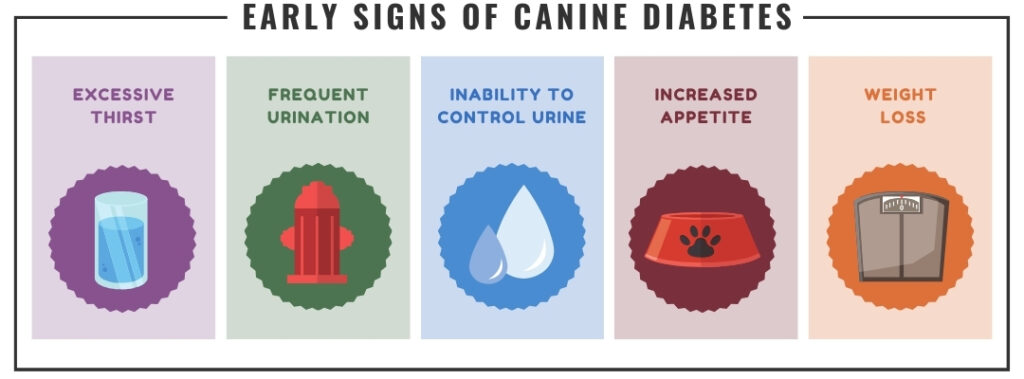Home » Pet Health » Pet Diabetes » Dogs Diabetes
Dogs Diabetes

Canine diabetes, medically recognized as Diabetes mellitus or “sugar diabetes,” is a common metabolism disorder in dogs. When a dog’s metabolism malfunctions, it will be unable to control the organs responsible for converting food into energy. In that case, the conversion of glucose into body fuel also becomes affected.
When food enters a dog’s body, the body breaks the nutrients down into glucose or sugar, an essential energy source for specific organs and cells. The glucose will then go to the bloodstream, where the pancreas releases the hormone insulin to convert different sugar levels into usable energy. Unfortunately, canine diabetes prevents this process, leading to large amounts of sugar accumulated in the blood.
If this medical condition becomes left untreated, Canine Diabetes can lead to severe damages to multiple organs, including the heart, eyes, or kidneys.
Types
We can classify Canine Diabetes into two main types, Type I and Type II. Type I canine diabetes or insulin-dependent diabetes refers to the process of preventing the pancreas from producing enough insulin. On the other hand, Type II or insulin-resistant diabetes impairs the body’s ability to respond to insulin appropriately.

Type I Diabetes (Insulin-Dependent Diabetes)
Type I or insulin-dependent diabetes is the most common type of canine diabetes. It occurs due to partial or complete destruction of the insulin-producing beta cells in the pancreas, which prevents average or sufficient production of insulin.
In the digestive system, glucose or sugar from food usually undergoes conversion into usable energy for the body. Nevertheless, glucose needs insulin to enter the cells. Without insulin, glucose remains and accumulates in the bloodstream, leaving cells starved for glucose-derived fuel and increasing the risk of multiple organ failure.
For dogs with this type of diabetes, administering daily insulin shots can help replace the missing insulin your dog needs.
Type II Diabetes (Insulin-Resistant Diabetes)
Type II Diabetes occurs when the pancreas succeeds in producing insulin, but the cells inside the body usually fail to respond to it. Some hormones prevent insulin from operating in the body correctly. Typically, this type of diabetes in dogs develops in overweight or obese dogs or those who consume unhealthy portions of carbohydrates every day.
However, it can also develop in unfixed dogs, taking steroid medications, or having Cushing’s syndrome. This said syndrome causes the body to produce excessive amounts of the steroid hormone cortisol.
Female dogs are also prone to having type II diabetes or insulin resistance during pregnancy or in heat.
Causes
Veterinarians still haven’t discovered the leading cause of canine diabetes. However, lifestyle, genetics, and the status of your dog’s immune system can highly influence the chances of developing the medical condition. For instance, type I diabetes mainly occurs as a result of an autoimmune disorder.
When a dog happens to have an autoimmune disease, its body will not distinguish between healthy cell tissues and potentially harmful foreign bodies. As a result, the body starts a reaction that causes the immune system to attack normal tissues.
On the other hand, type II Diabetes can result from obesity and the excessive consumption of carbohydrates. Since the body converts carbohydrates to glucose, carb immoderation causes blood sugar levels to rise, making cells resistant to insulin. However, unlike insulin-dependent diabetes, insulin-resistant diabetes is reversible in most cases.

Risk Factors
All dogs, regardless of breeds and ages, can develop canine diabetes. However, certain factors can make some dogs more susceptible to the condition than others. For instance, a dog’s gender, breed, age, medications, and even existing health conditions may increase its chances of falling victim to canine diabetes.
Fact Vs Fiction
Age

Middle-aged or senior dogs most commonly develop canine diabetes, specifically those older than seven years old. However, even dogs as young as 18 months can also have this condition. Nonetheless, young dogs, especially those below one year, can have a much lower risk of developing canine diabetes.
Gender

When it comes to dogs’ genders, unspayed female dogs are twice as likely to develop canine diabetes compared to male dogs (American Kennel Club, 2016). About 70% of the dog population with Canine Diabetes are female dogs. In some cases, the medical condition also develops in pregnant dogs, which veterinarians consider Gestational Diabetes.
Breed

A dog’s breed can also play a significant role in a dog’s susceptibility to Canine Diabetes. Some breeds, such as Toy Poodles, Cairn Terriers, Australian Terriers, Siberian Huskies, Keeshonds, Samoyeds, Bichon Frise, Miniature Pinschers, Japanese Spitz, and Schnauzers can become genetically predisposed to this condition.
On the other hand, other breeds, including Golden Retrievers, Boxers, German Shepherds, American Pit Bull Terriers, and American Cocker Spaniels, can be less susceptible to canine diabetes.
Steroid Medications

Veterinarians prescribe that steroid medications, such as prednisone and dexamethasone, can treat inflammatory conditions like severe allergic reactions, asthma, and arthritis. However, dogs should only take these when necessary and on a short-term basis. Dogs that take steroid medications longer than needed are at a higher risk of developing steroid-induced diabetes, a type of canine diabetes that results from steroids, causing the body to become resistant to insulin.
Cushing’s Syndrome

Cushing’s Syndrome causes the adrenal glands of the body to overproduce the steroid hormone cortisol, causing a similar problem as the long-term use of steroid medications: insulin resistance. This prevents the body from responding normally to insulin and without treatment, results in Canine Diabetes.
Pancreatic Damage

The pancreas is an essential body organ responsible for producing insulin in the body. However, it can become defective or inflamed due to various health conditions and situations, such as excessive steroids or chronic pancreatitis. If that situation happens, it can lead to the development of canine diabetes.
Obesity

Overweight or obese dogs are more prone to the development of type II or insulin-resistant diabetes. Overeating can cause excessive amounts of glucose to accumulate in the blood, desensitizing the body to insulin. If a dog ingests too much sugar and gains too much weight, the pancreas will no longer produce enough insulin to balance out the amount of glucose in the dog’s body.
Aside from lack of exercise, one of the leading causes of obesity in dogs is overfeeding. Even if your dog only eats two main meals a day, the kind and amount of treats you give them can significantly impact their weight. For instance, dog biscuits are usually high in carbohydrates. With that, we recommend going for healthier alternatives, such as freeze-dried treats that are low in calories and fat.
Signs and Symptoms
There are still no specific symptoms of canine diabetes. However, some possible signs can range from subtle changes in behavior, such as frequent urination and increased thirst, to more alarming symptoms, such as muscle weakness, seizures, and constant vomiting. These signs may still depend on the severity of the condition your dog has.
As blood sugar levels start to rise beyond normal, a dog’s body will begin to push the excess amount of glucose out through the urine, together with water that has bonded to the sugar. This situation causes diabetic dogs to become dehydrated, leading to drinking and urinating more than usual.

At the same time, the inability of glucose to enter the cells will make the body think that there is not enough sugar available to be converted into energy and cause the dog to feel hungry at all times. Despite eating regular or larger portions of food, diabetic dogs will continue to lose weight since the body is no longer retaining nor utilizing any nutrients.
Canine diabetes may cause exhaustion, vomiting, depression, loss of appetite, and recurrent infections in some cases. These situations may result from failure in controlling the condition adequately, leading the diabetic dog to be taken to the animal hospital immediately.
If this type of pet diabetes becomes left untreated, the condition could lead to more severe health concerns. These health problems may include urinary tract infection, heart problems, kidney failure, muscle loss or weakness, seizures, liver enlargement, blindness, cataracts, coma, and death.
Diagnosis
Various factors can trigger the development of canine diabetes. For that reason, a dog will need to undergo multiple laboratory tests to narrow down the potential causes and identify the underlying infections or diseases that can result from the health condition.
Since canine diabetes can occur more commonly in middle-aged and senior dogs, the presence of undetected medical conditions is highly possible. Usually, veterinarians will perform the following screening tests on dogs suspected of having Canine Diabetes:
Complete Blood Count

A Complete Blood Count or CBC provides detailed information about the red blood cells, white blood cells, and platelets found in a blood sample. This test allows veterinarians to evaluate the severity of the health condition and detect the presence of other underlying diseases or infections.
For example, dehydration can cause the number and volume of red blood cells to increase during the early stages of diabetes. In other cases, there can also be evidence of broken red blood cells or a low red blood cell count, indicating that the condition has progressed. Moreover, the number of white blood cells may also exceed the normal range, implying an existing disease or infection.
Serum Biochemistry Profile

A serum biochemistry profile measures various enzymes and chemicals in the blood, such as electrolyte levels, blood sugar concentration, and the number of blood proteins (albumin and globulin) inside the body of a diabetic dog.
Its primary purpose is to provide information about the status of the organs’ health and function. Elevated blood sugar levels, electrolyte imbalances, and high liver enzymes can indicate canine diabetes in this test.
Urinalysis

A urinalysis involves the physical, chemical, and microscopic examination of urine. Urinalysis in diabetic dogs will detect the presence of glucose or sugar in the urine. If a dog has an existing infection, it is also likely to see bacteria and white blood cells.
Top 5 Frequently Asked Questions
The eyes use glucose as a source of usable energy. However, if diabetic dogs have higher glucose levels, excess glucose can get converted into glucose sorbitol. If that happens, the glucose accumulated inside the eyes can pull water into the lens, where the function and clarity of a dog’s vision become damaged.
Consequently, cataracts will begin to form within 5-6 months after diagnosis. Diabetes-induced cataracts can also lead to complete vision loss within less than 48 hours.
Canine diabetes can be hereditary. Studies have also indicated that some dog breeds can be more susceptible to the development of the condition than others. With that, genetics may be one factor in developing canine diabetes.
Diabetic dogs may experience some seizures significantly when their blood sugar levels become lower than average. It may also happen when a dog does not eat for hours after administering insulin or when the insulin injected is excessive.
If a pet owner or veterinarian fails to control a dog’s blood sugar levels, the excess amount of glucose in the bloodstream may damage the blood vessels and block the proper distribution of nutrients. When that happens, it may affect hair growth and cause hair loss.
Additionally, underlying conditions impacting the production of hormones, like Cushing’s Syndrome, can cause the overproduction of the steroid hormone cortisol, leading to hair loss in many diabetic dogs.
High glucose levels can cause weak hind legs when uncontrolled correctly. Canine diabetes may affect a dog’s leg joints as sugar blocks nerve signals and causes muscle loss. With that, a dog loses strength, leading to back leg weakness.
Blogs

How To Identify Normal Cat Poop From Worrisome Ones?
Your cat’s poop can tell you many things about its health. Its color, shape, consistency, size, content, and odor can

Hairballs in Cats: What Are They & What Are The Signs?
Hairballs are common in cats. This condition, known as trichobezoar, occurs when hair becomes stuck in the cat’s throat, digestive

Colitis in Cats: What You Should Know
Colitis is one of the many gastrointestinal disorders that affect cats. It is a condition in which the intestine becomes

